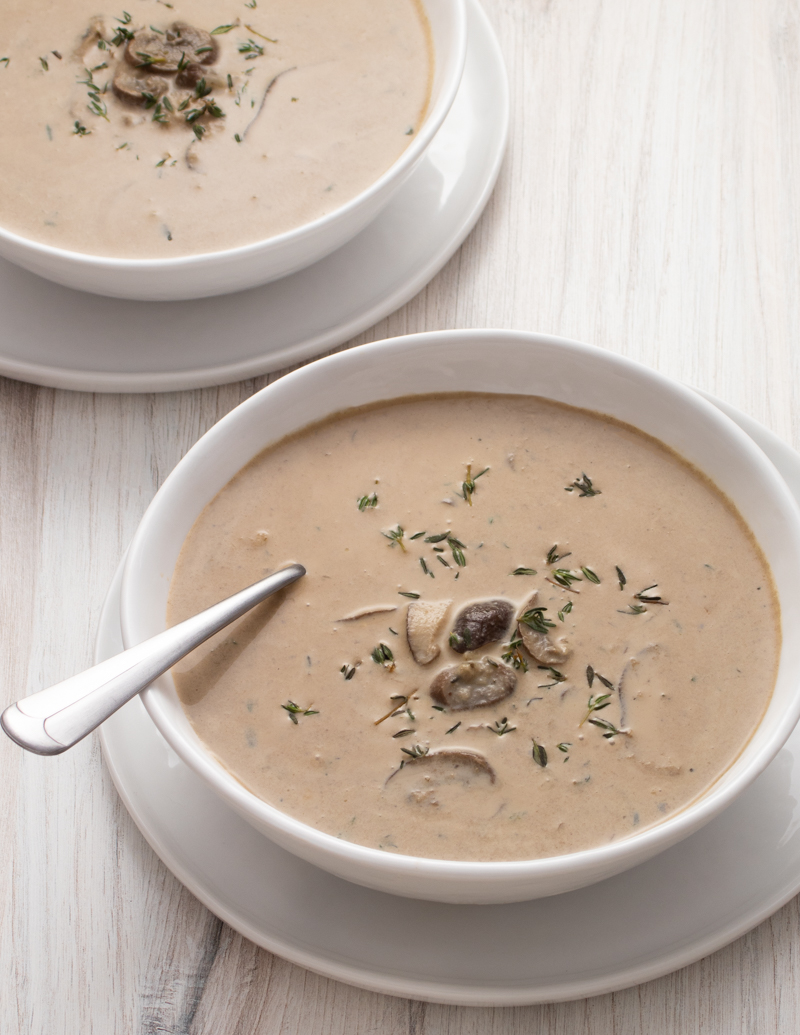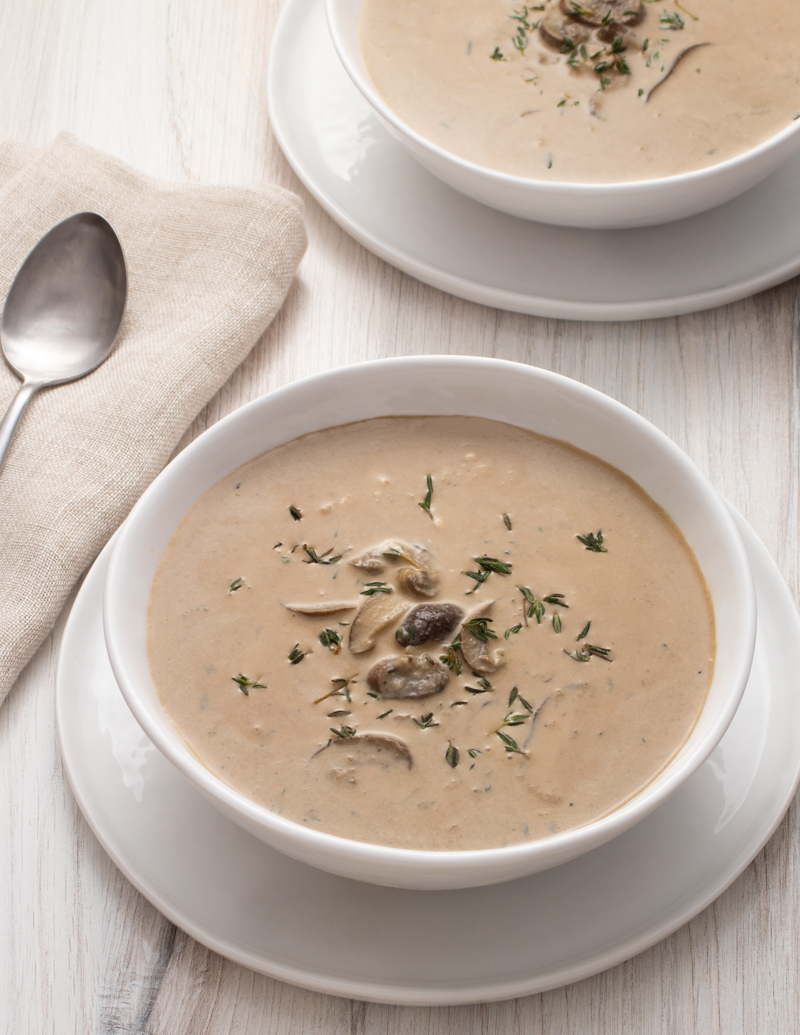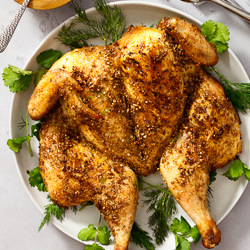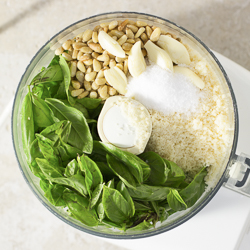It’s officially fall. Even in Napa, the days are still warm, but the nights are getting cooler and cooler. And I’m starting to crave soups. (As I write this, I’ve just polished off a bowl of the Mushroom Sherry Soup pictured in this post. Totally. Hits. The spot.)
The bad news about all that is, sadly, summer is over. The good news, though, is that it’s easy to satisfy a soup craving. Here’s a basic method for making soup out of pretty much any vegetable, quickly and easily.
1. Dice up some vegetables.
Do one type of vegetable or a combination. Mushrooms—mixed or all one type—for mushroom soup. Carrots and parsnips for carrot parsnip soup. Potatoes and leeks for potato leek soup. You get the idea.
Tip: Note that the smaller you cut up your vegetables, the more quickly they’ll cook, the more quickly your soup will be ready.
Another tip: Try to make the pieces of each type of vegetable the same size—otherwise, you’ll end up with some bits that are al dente while others are tender.
2. Heat a stockpot, add a little fat, and sauté the vegetables.
How big a stockpot? What kind of fat? Don’t worry about it too much—neither is particularly critical. Err on the side of a wider, shallower stockpot versus a narrower, taller stock pot, the better to brown your vegetables (see the tip below). And I use olive oil or a neutral-flavored oil like canola for my fat—enough to coat the bottom of the stockpot. Sometimes I add some butter if I want a buttery flavor in my soup, but I don’t recommend one hundred percent butter because it burns so easily.
As for the sauté, if you’re doing more than one type of vegetable, add the different types to your stockpot according to how long they’ll take to become tender—add the longest-cooking vegetables first and the quickest-cooking vegetables last, the intention being that they’re all tender at the same time.
Tip: Don’t stir the sautéing vegetables too often or you’ll sacrifice browning. Why is browning good? Well, think about how a poached or microwaved chicken breast tastes versus a pan-seared one. That difference in flavor is thanks to browning, or caramelization. Similarly, if you get some browning on your vegetables, your soup will have those brown, savory notes.
Another tip: Add some salt and pepper to the sauté. How much? Some. You’re going to season to taste later, so it’s not critical now.
3. Add liquid to cover.
The liquid can be stock, broth, water, wine, or a combination. Anything really. Note that if you add alcohol-based liquids, the alcohol will likely cook off by the time the soup is finished. So if you want a tinge of that alcoholic brightness, wait until the end to add your booze.
How much liquid? Err on the side of caution. You can always add more later, thinning out your soup, but if you add too much now, the only ways to get rid of it are to either strain it off, which means straining off some of the veggie flavors as well, or cook it down, which takes time and could result in overcooked veggies.
Tip: You know how we talked about getting some browning on the vegetables earlier? Well you’ll notice that when you brown a food, the bottom of your skillet or stockpot ends up with browning, too. So after you add our liquid, use a silicone spatula or other straight-edged tool to gently scrape around the sides and bottom of the pot, loosening up those flavorful browned bits and incorporating them into your soup. This, by the way, is called deglazing and it’s one of my most favorite cooking tricks.
4. Bring to a boil, reduce to a simmer, and cook until the vegetables are tender.
If you’ve cut up the vegetables into uniform pieces, and you’ve added each type in order of how long they take to cook—from longest-cooking to shortest—all the pieces should be tender at about the same time. If some are al dente while others are tender, it’s no big emergency, and you’ll know for next time.

5. If you want, puree all or part of your soup.
If you don’t puree, you soup will be a clear-ish liquid with pieces of vegetables floating around in it—perfectly acceptable. But if you’d prefer a creamier-textured soup, puree it. If you want a creamier soup that also has distinguishable pieces of vegetables floating around in it, puree only part of the soup. (That’s what I did for my Mushroom Sherry Soup.)
Tip: You can use a food processor, a blender, or an immersion blender to puree. A blender will give you the smoothest puree, which is not to say that a food processor’s puree won’t be smooth, but compared to a blender, it’ll be slightly grainier.
Another tip: Be careful pureeing hot liquids in a blender! They like to explode out the top and potentially burn you! To avoid this a) fill the blender only about 1/3 full, doing batches if necessary, b) start it at the lowest speed and work up to the highest, and c) just in case, hold the lid down with a several-times-folded kitchen towel.
6. If you want, adjust the consistency.
If your un-pureed soup has too high a proportion of vegetables to liquid, add more liquid. And if your pureed, or partially-pureed, soup is too thick, add more liquid.
7. Season to taste.
Salt and pepper—but especially salt—can make the difference between your vegetable soup tasting like dishwater and it tasting divine. For some guidance on seasoning to taste, read this post (the most applicable parts start about three paragraphs from the end).
8. If necessary, gently reheat.
Ta da! Homemade soup, quickly and easily.
If you’d like to sass up your soup, consider these enhancements.
Onions, shallots, or garlic is almost never a bad idea. Add them to the sauté, but note that finely chopped garlic will burn easily and so should be added just during the last minute or so.
Herbs can give your soup more dimension of flavor. Add heartier ones, like thyme and rosemary, to the sauté. Add delicate ones, like parsley and cilantro, either before pureeing or before seasoning.
Other enhancements include crème fraîche or cream for, you guessed it, creamy notes; wine, sherry, or brandy for boozy brightness; citrus zest for light, citrusy freshness; and a touch of soy sauce for low, savory oomph. Stir in any or all before pureeing or before seasoning.
Herbs, crème fraîche, flavored oils, and shaved, grated, or crumbled cheese also make nice garnishes.
And if you absolutely must have a recipe, here are a few.
(The first two illustrate this basic method, and the last few will give you more enhancement ideas.)
Mushroom Sherry Soup from my cookbook “100 Perfect Pairings: Small Plates to Enjoy with Wines You Love”
Easy Artichoke Soup with Spring Herbs
Colorful Lentil and Vegetable Soup
Chicken Soup with Rice
Simple, Satisfying Minestrone Soup










